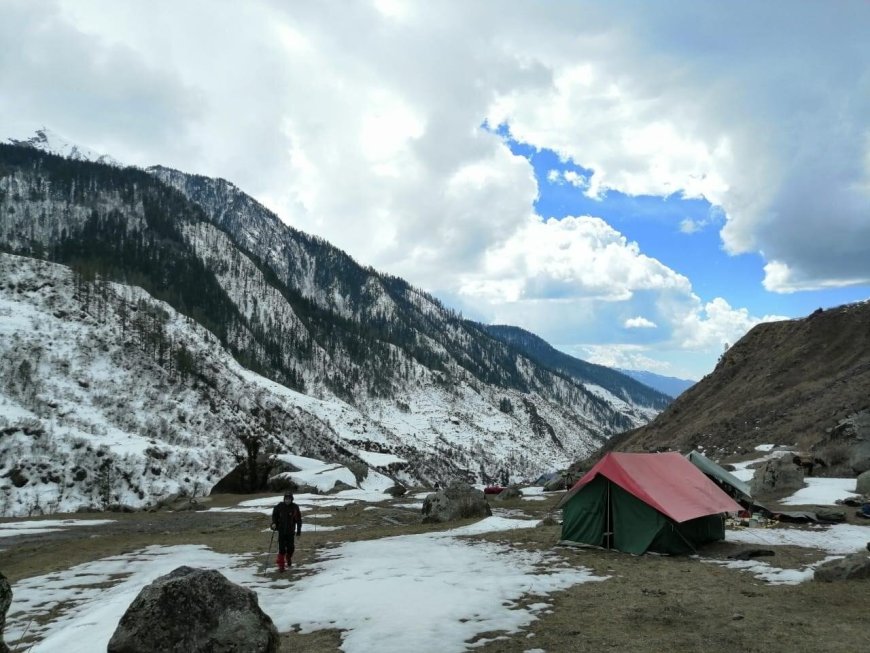Discovering the Best Time to Visit and Plan Your Har Ki Dun Trek in 2024 with Friends
Planning a trek to Har Ki Dun with friends can be an unforgettable experience, and understanding the best time to visit and how to plan your trip is crucial for making the most of this adventure.

Nestled in the western Garhwal Himalayas, the Har Ki Dun trek offers an exhilarating blend of natural beauty, cultural richness, and a touch of mythology. Known as the "Valley of Gods," this trek is ideal for adventure enthusiasts looking to explore pristine landscapes, dense forests, and ancient villages. Planning a trek to Har Ki Dun with friends can be an unforgettable experience, and understanding the best time to visit and how to plan your trip is crucial for making the most of this adventure. This article provides a comprehensive guide to help you and your friends prepare for an incredible Har Ki Dun trek in 2024.
Best Time to Visit Har Ki Dun
Choosing the right time to trek Har Ki Dun is essential for ensuring the best possible experience. The trek can be undertaken in two primary seasons: summer (April to June) and autumn (September to November).
1. Summer (April to June):
- Weather: The weather during summer is pleasant, with temperatures ranging from 10°C to 20°C during the day and dropping to 2°C to 5°C at night. The clear skies and blooming flora make it an excellent time for trekking.
- Landscape: The valley is lush green, and the forests are vibrant with blooming rhododendrons, making the scenery breathtakingly beautiful.
- Pros: Ideal for those who enjoy verdant landscapes and milder weather. The rivers and streams are full, adding to the valley's charm.
2. Autumn (September to November):
- Weather: Autumn offers clear skies and excellent visibility of the surrounding peaks. Temperatures during the day range from 12°C to 18°C, while nights can be chilly, dropping to -2°C to 5°C.
- Landscape: The post-monsoon season brings out the best in the flora, with golden and reddish hues dominating the landscape. The air is crisp and fresh, perfect for trekking.
- Pros: This season is ideal for those who prefer cooler weather and stunning, unobstructed views of the mountains.
Both seasons offer unique experiences, so your choice depends on whether you prefer the lush greenery of summer or the crisp, clear vistas of autumn.
Planning Your Har Ki Dun Trek in 2024
Planning a trek to Har Ki Dun involves several key steps to ensure a smooth and enjoyable journey. Here’s a detailed guide to help you prepare:
1. Research and Itinerary: Start by researching the trek thoroughly. Understand the route, the difficulty level, and what to expect in terms of terrain and weather. A typical Har Ki Dun trek itinerary spans 7 to 8 days.
Sample Itinerary:
- Day 1: Arrival in Dehradun and drive to Sankri (200 km, 8-10 hours).
- Day 2: Trek from Sankri to Taluka and then to Seema/Osla (12 km, 6-7 hours).
- Day 3: Trek from Seema/Osla to Har Ki Dun (11 km, 6-7 hours).
- Day 4: Explore Har Ki Dun valley and acclimatize.
- Day 5: Trek back from Har Ki Dun to Seema/Osla.
- Day 6: Trek from Seema/Osla to Taluka and drive back to Sankri.
- Day 7: Drive from Sankri to Dehradun.
2. Physical Preparation: The Har Ki Dun trek is moderately challenging, requiring a good level of physical fitness. Start your fitness regimen at least two months before the trek. Focus on cardiovascular exercises, strength training, and practice hikes to build stamina and endurance.
3. Packing Essentials: Packing the right gear is crucial for a comfortable trek. Here’s a list of essentials:
- Clothing: Layered clothing including thermal wear, fleece jackets, waterproof jackets, trekking pants, and comfortable T-shirts.
- Footwear: Sturdy trekking boots with good grip and ankle support. Bring extra pairs of socks.
- Accessories: Hat, sunglasses, gloves, and a headlamp with extra batteries.
- Backpack: A durable backpack with rain cover, and a smaller daypack for essentials.
- Sleeping Gear: A warm sleeping bag suitable for sub-zero temperatures.
- Miscellaneous: First aid kit, personal medications, water bottles, energy bars, sunscreen, and toiletries.
4. Permits and Guides: Obtain necessary permits for the trek, which can be arranged in Sankri. Hiring a local guide or joining a trekking group is advisable for safety and a richer cultural experience. Guides can provide valuable insights into the local flora, fauna, and folklore.
5. Acclimatization and Health: Acclimatization is crucial to prevent altitude sickness. Take it slow, stay hydrated, and listen to your body. Include a rest day in your itinerary to acclimatize properly. Carry a basic first aid kit, including medicines for altitude sickness, pain relief, and digestive issues.
6. Responsible Trekking: Practice Leave No Trace principles. Carry all waste back to designated disposal points and avoid disturbing the local ecosystem. Respect local customs and traditions, and support local businesses by purchasing supplies and souvenirs from them.
Experience Highlights with Friends
Trekking Har Ki Dun with friends can be a bonding experience, filled with memorable moments and shared adventures. Here are some highlights to look forward to:
1. Scenic Beauty: The trek offers stunning views of the Swargarohini and Bandarpoonch peaks. The lush green valleys, dense forests, and alpine meadows create a picturesque backdrop for your journey.
2. Cultural Immersion: Interacting with the villagers of Osla and Seema provides a glimpse into the local culture and way of life. The wooden houses, traditional attire, and warm hospitality add a rich cultural dimension to the trek.
3. Mythological Significance: Har Ki Dun valley is steeped in mythology, believed to be the route taken by the Pandavas in the Mahabharata on their way to heaven. Exploring these ancient trails adds a sense of history and intrigue to the trek.
4. Adventure and Bonding: The challenges of the trek, from crossing rivers to navigating steep trails, foster teamwork and camaraderie. Sharing campfire stories, setting up tents, and cooking meals together enhance the group experience.
5. Wildlife and Nature: The trek through the Govind National Park offers opportunities to spot diverse flora and fauna, including Himalayan monal, black bears, and langurs. The rich biodiversity and natural beauty make the journey even more rewarding.
Conclusion
The Har Ki Dun trek is a perfect blend of adventure, natural beauty, and cultural richness. Whether you choose to visit in the vibrant summer or the crisp autumn, planning your trek with friends promises to be an unforgettable experience. Proper preparation, including physical fitness, packing the right gear, and respecting the local environment, ensures a safe and enjoyable trek. So gather your friends, gear up, and embark on the Har Ki Dun trek in 2024 for an adventure that will create lifelong memories.
What's Your Reaction?
 Like
0
Like
0
 Dislike
0
Dislike
0
 Love
0
Love
0
 Funny
0
Funny
0
 Angry
0
Angry
0
 Sad
0
Sad
0
 Wow
0
Wow
0













































